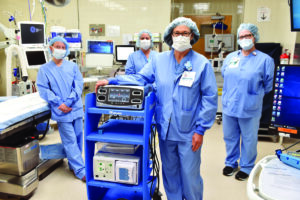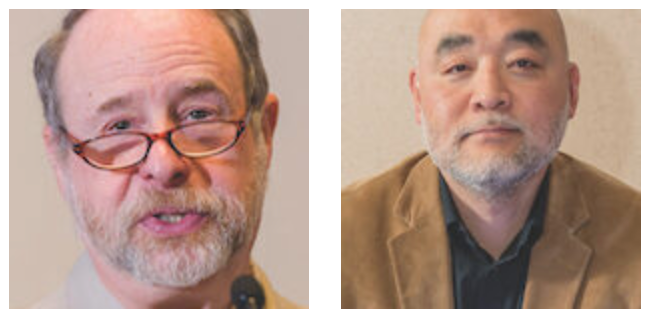Points of Pride
Backus nurse helps OR clear the smoke
by Elissa Bass
After reading in professional journals about the need to reduce surgical smoke for staff and patient health, Backus Hospital operating room nurse Ann Hanson decided to take action.
The project she launched earned the Association of periOperative Registered Nurses’ (AORN) highest rating through its Go Clear AwardTM pro- gram.
Surgical smoke — a byproduct of energy-generating devices like electrosurgery units, lasers, ultrasonic devices, powered surgical instruments — can carry microscopic levels of toxic gases, viruses, cells and blood.
AORN’s program recognizes facilities working to ensure a smoke-free environment. More than 500 surgical units nationwide participate.
“I’m so proud of the team for putting in the work to receive such an important recognition,” said East Region Vice President of Patient Care Services Laura Currie. “Their ongoing commitment to quality and safety is what helps patients choose Backus for their care.”
In 2019, Hanson brought the proposal to her supervisors, who embraced it. A volunteer group coordinated presentations for nurses, physicians and surgical technologists on surgical smoke hazards and how to reduce it.
Equipment such as smoke evacuation units were purchased, and physicians tested different cauterizing tools to find the best for performance and low smoke.
Cauterization, Hanson estimated, is used in 85 percent of procedures in Backus ’12 ORs and two C-section rooms.
“I’m very happy with the result,” she said. “The system has been fully implemented, all the staff are educated and we’ve had buy-in from physicians. We are now at 90- to 100-percent levels of smoke evacuation.”
 Ann Hanson, MSN, RN, foreground, stands in Backus operating room 1 with some of the equipment involved in clearing the air of surgical smoke produced in the OR during cauterization. A smoke evacuation unit on the bottom of the cart contains filters that reduce smoke and tiny particles in the air produced during the cauterization process. Hanson’s efforts, along with others in the OR including, back row left to right, Sheena Morgan, CST; Kerri Scarchilli, RN, and Maria Amaral, RN, helped the hospital receive the highest rating from the Association of periOperative Registered Nurses (AORN) in its Go Clear Award program.
Ann Hanson, MSN, RN, foreground, stands in Backus operating room 1 with some of the equipment involved in clearing the air of surgical smoke produced in the OR during cauterization. A smoke evacuation unit on the bottom of the cart contains filters that reduce smoke and tiny particles in the air produced during the cauterization process. Hanson’s efforts, along with others in the OR including, back row left to right, Sheena Morgan, CST; Kerri Scarchilli, RN, and Maria Amaral, RN, helped the hospital receive the highest rating from the Association of periOperative Registered Nurses (AORN) in its Go Clear Award program.
Winsted HealthCenter eyed as catalyst for growth
by Tim Lebouthillier
“New health center seen as driving a rebirth of Winsted’s Main Street” read the local paper’s headline on January 22, 2021, capturing a very exciting moment many years in the planning with the opening of Hartford HealthCare’s (HHC) new, state-of-the-art, health center at the corner of routes 8 and 44.
Local officials hail the new facility as a psychological and tangible boost for Winsted’s economy and patients quickly reacted to having expert care closer to home. Donna, the first to experience care at the new HHC Rehabilitation Network’s outpatient clinic within the Health- Center, called it “beautiful and spacious.”
The nearly 30,000-square foot building is home to many of services formerly housed across town at Winsted Health Center, formerly Litchfield County Hospital. The new facility features seven-
day emergency department, mammography, physical and occupational therapy, blood draw, CT scan, cardiac rehabilitation, primary care and specialty care in podiatry, cardiology, surgery, GI and OB/GYN.
The three-level facility stands alongside the Northwestern Connecticut Community College Joyner Health Science Center and the proximity presents collaborative healthcare education opportunities with the college.
Construction proved unusually challenging for Avon-based CASLE Corporation. The site is located on a ridge with rising elevations so construction required extensive digging, screening and replacing fill, which was compacted and vibration tested to ensure the foundation remains safe and solid. Hundreds of truckloads of clean fill were also brought in to level the area and construct a 30-foot retaining wall for an adjacent LIFE STAR helipad.
IOL joins NIH schizophrenia in young adults study
by Susan McDonald

Joining an international study to better understand schizophrenia in high-risk young adults puts the Institute of Living (IOL) “on the map regarding a critical area in psychiatry,” according to Dr. Godfrey Pearlson, top left, co- principal investigator of the IOL team.
He and Dr. Jimmy Choi, top right, assembled colleagues from the IOL’s Olin Neuropsychiatry Research Center and Advanced Services for Adolescents with Psychosis
Program to join the $52-million, five-year study funded by the National Institutes of Health (NIH) to develop a Psychosis Risk Outcomes Network (ProNET) while characterizing biomarkers associated with psychosis risk.
They will test whether variations in these biomarkers can predict those most likely to benefit from specific treatments.
“Similar to finding if people are at increased risk for heart disease, we want to identify and treat these individuals successfully before they become manifestly sick. Identifying them when treatment is more straightforward and the condition less distressing is critical,” Dr. Pearlson said.
The IOL team includes co-investigators Dr. Michael Stevens; Patricia Graham, LMSW; and Dr. Jennifer Zajac.
Globally, 3.2 to 7 percent of youth have early symptoms of schizophrenia or psychosis. Some develop other mental health conditions like depression or bipolar disorder, while others manage symptoms alone or with professional help.
ProNet researchers will recruit more than 1,200 youth and mine existing patient data for schizophrenia biomarkers. They will also exam- ine participants’ cognitive ability, family history, education, psychological trauma, environmental exposure to toxins and social involvement.
The goals, Dr. Choi said, are to identify which biomarker or combination shows before a problem develops, and to determine if treating or eliminating it prevents schizophrenia. “(We hope) to identify the biomarker for very early treatment — genetic therapy, reduction of family stress, normalization of abnormal brain electrophysiology, etc. — that may prevent schizophrenia,” he said.
Applying treatments will be studied after the five-year grant.
Tim Lebouthillier
Infusion Center brings care closer to home
by Tim Lebouthillier
With more than 3,000 square feet of space, a new patient center opened on the sixth floor of the main building at Charlotte Hungerford Hospital to provide infusion services under the direction of the Hartford HealthCare Cancer Institute.
The center is supported by the presence of three new medical oncology providers in the area who join with Charlotte Hungerford’s longstanding radiation therapy program and the region’s first certified breast surgeon to comprise the first phase of the Institute’s plan to expand advanced and comprehensive cancer services in the area.
Center turns spine care right side up
by Susan McDonald
 Dr. Khalid Abbed, with scissors, joined with Hartford HealthCare leadership to formally open the Spine Wellness Center in Westport. Photo by Amy Mortensen
Dr. Khalid Abbed, with scissors, joined with Hartford HealthCare leadership to formally open the Spine Wellness Center in Westport. Photo by Amy Mortensen
In a system he called “upside down,” Dr. Khalid Abbed envisioned a holistic approach to treating spine and back pain, where surgery is a possibility but not the first or only consideration.
The medical director of the Spine Wellness Center, Westport, wants to “flip the pyramid” to treat the causes of back pain while addressing issues altering patients’ quality of life.
One of the most common reasons people go to the doctor, back pain affects 80 percent of Americans at some point, Dr. Abbed noted. Depending on location and severity, pain can affect work and quality of life. For some, surgery is not an option due to other health issues.
“A lot of people would just give up on life,” he said. “There was no place to send them and no way to help them. I tell them, ‘We’re here to deal with it with you.’”
As pain affects the mind and spirit, the Spine Wellness Center draws together services aimed at improving the person’s physical fitness to relieve back pain, and those addressing depression, poor sleep or dietary habits that worsen pain and quality of life.
“These are people who will be back for surgery if they don’t address all of those things,” he said. “When you ignore the mind, you’re missing so much. We delve into aspects of consciousness, mentality and spirituality.”
Services are tailored to patient needs and can include yoga or meditation classes, lessons with a nutritionist in the Center’s teaching kitchen or supervised gym workouts to help with weight loss or core strengthening.
The wellness, health and lifestyle options seamlessly integrate with the clinical expertise of Ayer Neuroscience Institute neurologists, neurosurgeons, pain specialists, health psychologists and physical therapists from the Hartford HealthCare Rehabilitation Network.
“We put it all under one roof,” Dr. Abbed said. “I hope this will become the standard of care — to get people to care about their health.”
Fairfield broadens community presence
by Anne Rondespierre-Riczu
 Neurology and urology services share new office space in Stamford, bringing the Ayer Neuroscience and Tallwood Urology & Kidney institutes together for patients in Fairfield County. Photo by Christine Sniadack
Neurology and urology services share new office space in Stamford, bringing the Ayer Neuroscience and Tallwood Urology & Kidney institutes together for patients in Fairfield County. Photo by Christine Sniadack
With more than 3,000 square feet of space, a new patient center opened on the sixth floor of the main building at Charlotte Hungerford Hospital to provide infusion services under the direction of the Hartford HealthCare Cancer Institute.
The center is supported by the presence of three new medical oncology providers in the area who join with Charlotte Hungerford’s longstand- ing radiation therapy program and the region’s first certified breast surgeon to comprise the first phase of the Institute’s plan to expand advanced and comprehensive cancer services in the area.
